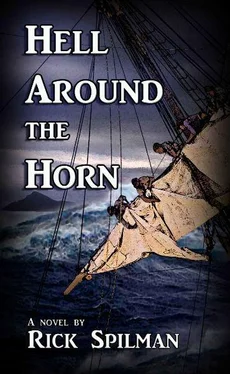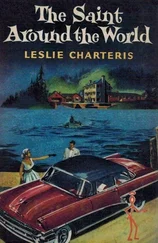Rick Spilman - Hell Around the Horn
Здесь есть возможность читать онлайн «Rick Spilman - Hell Around the Horn» весь текст электронной книги совершенно бесплатно (целиком полную версию без сокращений). В некоторых случаях можно слушать аудио, скачать через торрент в формате fb2 и присутствует краткое содержание. Жанр: Морские приключения, на английском языке. Описание произведения, (предисловие) а так же отзывы посетителей доступны на портале библиотеки ЛибКат.
- Название:Hell Around the Horn
- Автор:
- Жанр:
- Год:неизвестен
- ISBN:нет данных
- Рейтинг книги:4 / 5. Голосов: 1
-
Избранное:Добавить в избранное
- Отзывы:
-
Ваша оценка:
- 80
- 1
- 2
- 3
- 4
- 5
Hell Around the Horn: краткое содержание, описание и аннотация
Предлагаем к чтению аннотацию, описание, краткое содержание или предисловие (зависит от того, что написал сам автор книги «Hell Around the Horn»). Если вы не нашли необходимую информацию о книге — напишите в комментариях, мы постараемся отыскать её.
Lady Rebecca
Hell Around the Horn
Hell Around the Horn — читать онлайн бесплатно полную книгу (весь текст) целиком
Ниже представлен текст книги, разбитый по страницам. Система сохранения места последней прочитанной страницы, позволяет с удобством читать онлайн бесплатно книгу «Hell Around the Horn», без необходимости каждый раз заново искать на чём Вы остановились. Поставьте закладку, и сможете в любой момент перейти на страницу, на которой закончили чтение.
Интервал:
Закладка:
Rick Spilman
Hell Around the Horn
To Karen, for all her love and support
Acknowledgments
Thanks to my editor, Broos Campbell, and my proofreader, Karen Lorentz. Thanks also for the insight and support of the members of my critique group - Bruce Woods, Ken Kraus, Kelly O'Donnell, Shelley Nolden, Jael McHenry, and Cathy DiCairano. A special thanks also to the authors Joan Druett, Alaric Bond, Linda Collison and Bob McDermott for their valuable comments and guidance. I would also like to thank the readers and contributors to the Old Salt Blogfor all their encouragement and support.
Introduction
Hell Around the Horn is a work of fiction inspired by a particular voyage around Cape Horn by the windjammer British Isles in 1905. (I think that British Isles is a horrible name for a ship so, in the novel, I renamed her Lady Rebecca .) While all the characters in the novel are fictional, many were inspired by the real officers and crew aboard the British Isles. Captain James Pratt Barker, his wife Mary and their children sailed aboard the ship as did, Apprentice William Jones, Mate Rand, Second Mate Atkinson, the Welsh sailor G.H. Harhy, the sail-maker Pugsley and the carpenter Gronberg. The American sailor, Fred Smythe, is a composite of many of the young educated sailors who sailed before the mast in the latter days of sail. He was inspired most directly by Fred Harlow but was also borrowed in part from Richard Henry Dana, Herman Melville, Felix Riesenberg and Basil Lubbock, among others.
The novel itself was directly inspired by " The Log of a Limejuicer: The Experiences Under Sail of James P. Barker, Master Mariner, " by James Barker and Roland Barker; " The Cape Horn Breed," by Captain William H. S. Jones and " The War with Cape Horn, " by Alan Villiers. Specific scenes were inspired by " The Brassbounder ," by David W. Bone and " By Way of Cape Horn " by Paul E. Stevenson.
If you are challenged by the nautical jargon or terminology, there is a glossary in the back of the book for your reference. It is linked to in the Table of Contents.
1. River Plate
Captain William Jones paused on the bridge wing as the Mormacmar steamed up the River Plate. The blue of the Atlantic had turned a dull gray, colored by the silt of the dozen tributaries of the Paraná and the Uruguay rivers that flowed into the Río de la Plata, the river of silver, as the Spanish called it, an optimistic name for a muddy estuary.
He turned and again paced slowly from the bridge wing to the helm where the river pilot stood next to the mate on watch. The mate relayed orders to the quartermaster at the wheel, as they followed the channel markers and began the slow turn into the harbor of Montevideo. It was Captain Jones' first trip on the river and he kept an eye out for the Barra del Indio, the shoal that had marred so many a captain's reputation. He also watched for the fishing boats that swarmed on the river. Running down a local fisherman was no way to announce their arrival. From time to time, the pilot glanced his way quizzically, but Captain Jones just continued his slow pacing.
Then, on the Uruguayan shore, something caught his eye—an old hulk, steel, judging by the deep rust red of the hull. There were many old ships broken by time and Cape Horn on this coast, abandoned by bankrupt or merely indifferent owners. He took the binoculars from the case by the bridge door and trained them on the shoreline. "My God," he murmured softly to himself. "Oh, my God.”
Once alongside the wharf in Montevideo, the captain met with customs, spoke with the port captain and port purser, discussed the discharge with the mate and listened to the chief steward about provisions and to the chief engineer about a problem with a feed-pump gasket.
Captain Jones would have liked nothing more than to retreat to his bunk. He had been on his feet for eighteen hours. But he couldn't sleep until he knew for certain. He climbed down the outside stairs to the main deck and found the mate.
“I'll be ashore for a few hours.”
“Aye, sir," the mate replied, before getting back to his gang knocking the wedges from the hatch tarps.
The marine superintendent in the office ashore greeted him warmly, called for coffee and sent a boy to find a boat as the capitano required. Within an hour, Captain Jones was a passenger in an immaculate steam launch, all white paint and polished bronze with a diminutive single-cylinder steam engine and a tiny boiler, under the command of a short but proud boatman in a sailor's rig at the tiller. The launch chugged noisily out beyond the breakwater and danced in the short chop of the estuary.
At first Captain Jones couldn't find the old ship. Had he imagined her? Then, around a shallow point on a rocky beach, there she was, an abandoned derelict, but, to his eyes, still lovely. She lay listing slightly to starboard. Only her lower masts still rose above her rusty hull, but even without her rigging there was no doubt that she was a sailing ship. Her lines were long and smooth and her hull was deep with none of the ugly boxiness of a steamer. Even in death, she was a still a windjammer.
He was certain now. She was the Lady Rebecca, his first ship. He knew her too well not to recognize the arc of her bow or the half-deck in front of the poop where he had begun to learn his trade. The launch bobbed in the surf and the boatman called out, "¿ Quieres ir a tierra ?" The captain shouted back, " Si, a tierra ." The boatman nodded, pushing the tiller over, pointing the bow toward the beach, as the little steamer chugged toward shore.
2. Lady Rebecca , Cardiff, Wales
The steel windjammer Lady Rebecca lay alongside Bute Dock in Tiger Bay, Cardiff. Her three masts gleamed white, rising from her black hull, soaring up over the dock walls, the cargo cranes and warehouses, seeming almost to reach the wispy clouds in an otherwise deep blue summer sky.
Will Jones, all of 14, a "brassbounder," wearing a snug blue tunic, closed with a row of shiny brass buttons, dropped his heavy sea chest and looked up at the ship in speechless wonder. He stood like a half-tide rock, oblivious to the traffic of sailors, riggers and longshoremen that surged around him on the dock. The young man, with closely trimmed fair hair and a freckled nose, stood up straight and proud as an admiral. He had never actually been to sea, but had studied for two years at the Trinity School of Navigation, so he thought of himself as highly experienced, despite his lack of sea time. His parents had paid the considerable sum of thirty pounds for his apprenticeship aboard the Lady Rebecca .
Before leaving home, he had memorized the ship's characteristics from a borrowed copy of Lloyd's Register of Ships , until he could recite them by heart. The Lady Rebecca —steel, three-masted, a full-rigged ship, 309 feet long, 44 feet of beam, 25 feet of depth. 2,530 tons register, 4,000 deadweight. Main yard—105 feet long. The masthead—180 feet above deck. Now, the figures became wholly inconsequential before the towering mass of the ship herself.
The bowsprit and jib-boom jutted out boldly, reaching high over his head. Will's gaze followed the line of the forestay as it soared up the dizzying heights to the top of the foremast.
The Lady Rebecca thrilled and terrified him. She was so massive, so powerful. Standing before her, Will felt very, very small. He wondered whether he had the strength to sail on such a ship. Suddenly, he wasn't so sure. His only comfort was the beautifully carved figurehead of the ship's namesake, a young woman in modern attire wearing a plumed hat, who looked down on him with a gaze that was not entirely unkind.
Читать дальшеИнтервал:
Закладка:
Похожие книги на «Hell Around the Horn»
Представляем Вашему вниманию похожие книги на «Hell Around the Horn» списком для выбора. Мы отобрали схожую по названию и смыслу литературу в надежде предоставить читателям больше вариантов отыскать новые, интересные, ещё непрочитанные произведения.
Обсуждение, отзывы о книге «Hell Around the Horn» и просто собственные мнения читателей. Оставьте ваши комментарии, напишите, что Вы думаете о произведении, его смысле или главных героях. Укажите что конкретно понравилось, а что нет, и почему Вы так считаете.












